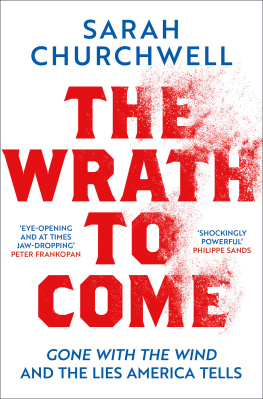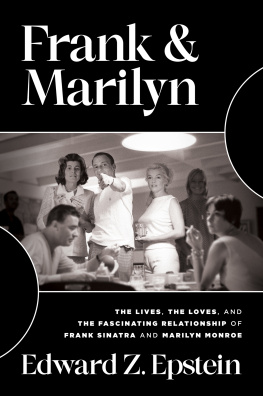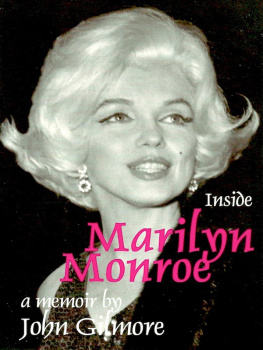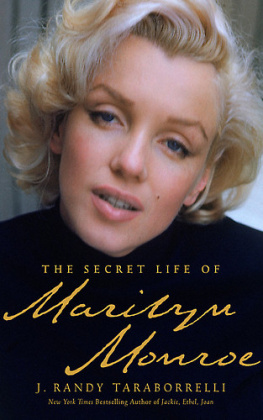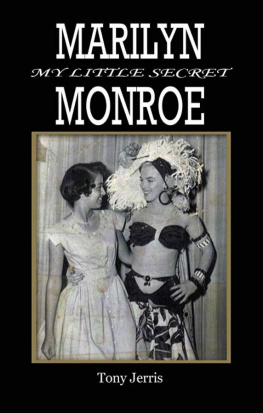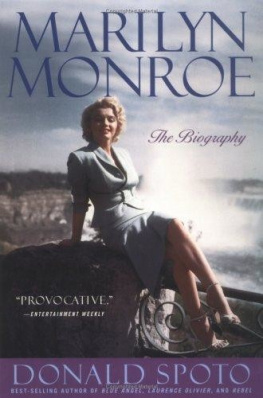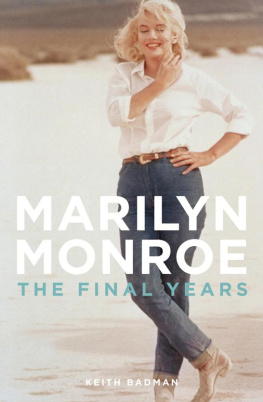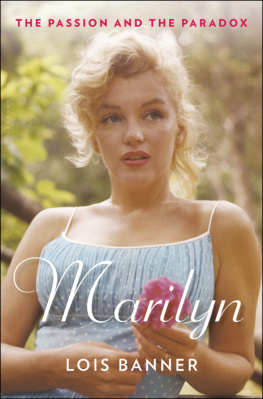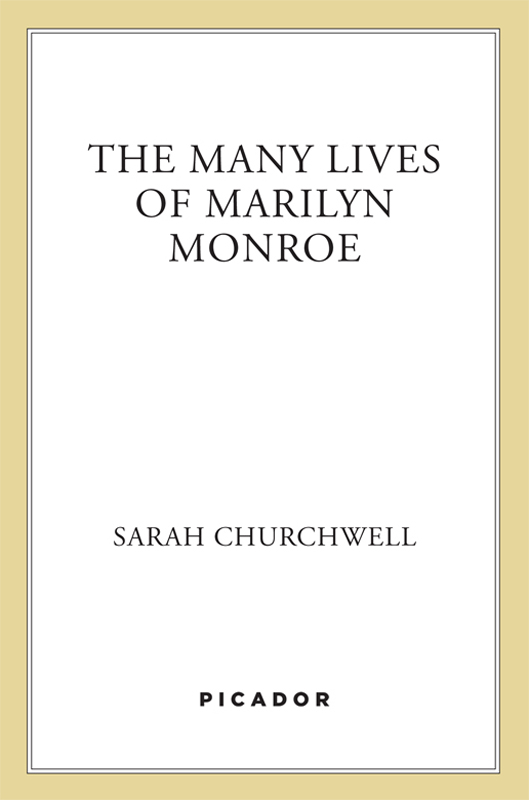
The author and publisher have provided this e-book to you for your personal use only. You may not make this e-book publicly available in any way. Copyright infringement is against the law. If you believe the copy of this e-book you are reading infringes on the authors copyright, please notify the publisher at: us.macmillanusa.com/piracy.
CONTENTS
NOTE ON SOURCES
This book seeks to understand the myriad stories in circulation about Marilyn Monroe, to read the public myth. It does not promise (or indeed endeavor) to reveal the private woman. I have in consequence restricted myself to publicly available stories, documents and images, in an effort to understand the story that is produced by, and for, our culture and that circulates within the public sphere.
In addition to the specific works cited in the text, the discussion that follows has been enlightened by the insights of many scholars and critics. Foremost among these are Susan Bordo, Judith Butler, Michel de Certeau, Michel Foucault, George Lakoff and Mark Johnson, Joan W. Scott and Eve Kosofsky Sedgwick. The discussion of Snow White at the end of chapter six is indebted to the reading offered by Sandra M. Gilbert and Susan Gubar in The Madwoman in the Attic. These thinkers have provided another key source for this book.
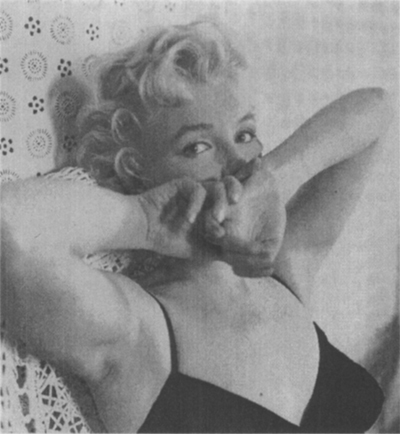
Marilyn Monroe, 1956 . PHOTOGRAPH BY CECIL BEATON .
INTRODUCTION
Youre always running into peoples unconscious.
MARILYN MONROE ,
Life interview, August 3, 1962
Sometime during the night of August 4, 1962, Marilyn Monroe died of an overdose of barbiturates. She was alone in the bedroom of her new home at 12305 Fifth Helena Drive, an unpretentious Spanish bungalow in Brentwood, California, that she had only recently purchased. It was the first house she had owned by herself; in the summer of 1962, divorced three times, Marilyn Monroe lived alone. Her dead body was discovered in bed, naked. There was no note, but there were dozens of pill bottles on the bedside table, most of them empty. When the first policemen arrived they found Monroes housekeeper doing the laundry. And they began to hear conflicting stories about the events that had taken place between 8 P . M . on August 4 and 4:25 A . M . on August 5, when they were notified.
These reports would only grow more confused and disordered as time passed and more voices added to an already convoluted tale. The disputes have never been resolved, and conflicting stories continue to spread, scrambling fact, speculation, belief and accusation. The coroners official verdict was probable suicide, but the myth is not satisfied with the probable. New stories appear regularly, each of which promises to deliver the trutha different truthat last. More often than not they only offer another tangled web of anecdote and conjecture, and these competing myths have become the only truth we have.
In some stories Marilyn kills herself, in despair over the end of her career, or a love affair, or both. In others, she was never happier: her career was flourishing, she was about to marry. Most of the tales, though, are murder mysteries, and the culprit varies from one account to the next. The Kennedy men (not just John and Robert, but in some variants their father, Joseph) are fingered most often, but she might have been murdered by the Mobor Jimmy Hoffa, or the CIA, or J. Edgar Hoover and the FBI, or Communists (some prefer Khrushchev, others Castro). In some versions it was her psychiatrist whodunit, in others her housekeeper. It was assassination. It was accident. She was destroyed by the powerful men who manipulated her. She was her own worst enemy.
Each of these endings concludes its own plot, and each plot differs in key respectsyet they all insist that theirs is the true story of Marilyn Monroes life.
The authors of these tales are not all paranoid cranks. Monroes major biographers differ widely about her death, and many respected writers have accepted the possibility that Marilyn could have been murdered. After the Profumo scandal, Watergate, Vietnam, Iran-Contra and the Clinton-Lewinsky affair, the prospect of a cover-up at the highest levels of government is not only not paranoid, it is politics as usual. In his 1973 novel biography Marilyn , Norman Mailer lingered over the likelihood of Monroes murder and on the political stakes riding on her death, before admitting that evidence of homicide was hard to find. Nearly thirty years later, in her biographical novel Blonde , Joyce Carol Oates attributed Monroes death to a Sharpshooter working for the Agency, who neither knows nor cares why hes killing her: the murder was either ordered by friends of R.F. or else by his enemies. (And calling him a Sharpshooter can only invoke the death of J.F.K., for Oatess Sharpshooter never actually shoots anyone but rather kills Marilyn by lethal injection.) The stories that believeor toy withthe possibility that Marilyn Monroe was murdered depend for their motive upon the assumption that she was having an affair with Robert Kennedy, but that theory itself is by no means proven; some of Monroes biographers continue to dismiss it as unfounded.
What is the truth? And how can we possibly not know everything there is to know about one of the worlds most oversold icons?
* * *
It is hardly news that Marilyn Monroes death remains controversial. More surprisingly, the mysteries surrounding her death are not the only confusions in her story. Uncertainty is the story of Marilyns biographical life: we dont know nearly as much about her as people may assume. Although Marilyn Monroe was one of the most famous, most photographed, most written-about people in the twentieth century, we know less about her for certain than about many far more distant historical figures.
It is not just the case that biographies of Marilyn Monroe disagree about the answers to charged questions about her life, her character and her experiences. They often do not acknowledge that other versions even exist. Each of Marilyns many lives asserts as proven fact what another calls a total lie, and presents conjecture as if it were certain knowledge. Often only after several accounts have been compared does controversy emerge, and only by reading many do the stakes of the arguments begin to appear.
Whichever biography of Marilyn Monroe we read, however, we are instantly confronted with an identity that seems confused, secret, lost. Biographies then promise to clear up these confusions, reveal the secrets, reclaim the lost soul. But these many lives help to create the confusion in the first place.
Why not assume that Marilyn Monroe opens the entire problem of biography? asks Norman Mailer, with a characteristic mix of presumption and insight. That problem, for Mailer, is the question of whether a person can be comprehended by the facts of a life. But in Marilyns case those facts cannot even be established with confidence in the first place. Much of what we think we know about Monroe the person is actually extrapolated from the persona of Marilyn.
The myth of Marilyn is not without correlatives: she can be (and has been) compared to other iconic figures who died young and have had their images endlessly reproduced and their stories forever recycled. She and Elvis often take a bow together; sometimes James Dean comes into the story. But Marilyn, that icon of ber-femininity, is most often compared to other dead women. Or rather, other dead women are often compared to her. To take just one example, when Princess Diana died in September 1997 the New Statesman wrote: By dying young, at the peak of her fame, she has taken her place in the holy trinity of immortal blondes. The more beautiful Marilyn Monroe overdosed wearing Chanel No. 5. The more intelligent Sylvia Plath died with her head in a gas oven like a Sunday roast. Whenever a glamorous young woman dies, she is compared to Marilyn Monroe, whether she was a blondeor dumbor not. Plath, who was only blonde for one summer and died six months after Monroe, is regularly described as the Marilyn Monroe of literature. Janis Joplin, far less blondeand less likely to appreciate the comparisonis an even more incongruous member of the sorority, coupled to Marilyn in death with startling frequency. A study titled Virginia Woolf: Icon , by Brenda R. Silver, ends on a chapter called The Monstrous Union of Virginia Woolf and Marilyn Monroe. Shes been compared to Eva Pern and Marina Tsvetaeva. And of course, when Diana died, it wasnt just the comparison that was recycledthe myths theme song, Candle in the Wind, was, as well.


